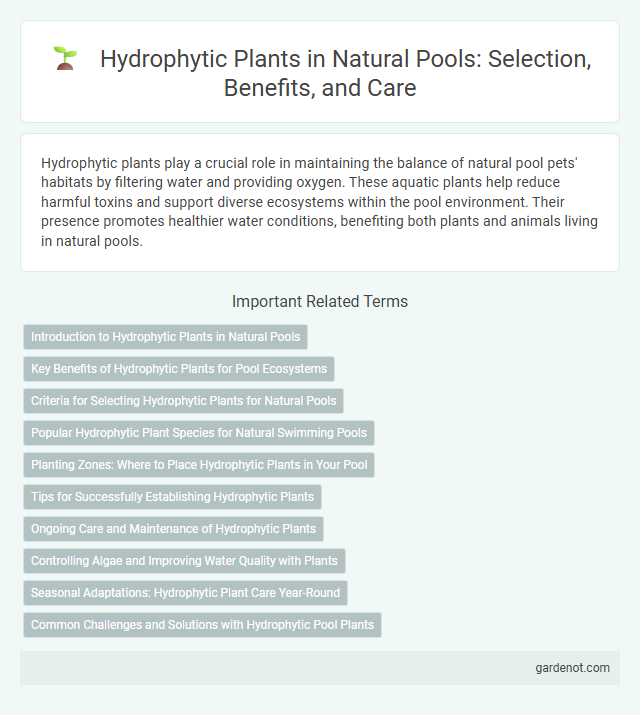Hydrophytic plants play a crucial role in maintaining the balance of natural pool pets' habitats by filtering water and providing oxygen. These aquatic plants help reduce harmful toxins and support diverse ecosystems within the pool environment. Their presence promotes healthier water conditions, benefiting both plants and animals living in natural pools.
Introduction to Hydrophytic Plants in Natural Pools
Hydrophytic plants thrive in water-saturated environments and play a crucial role in natural pools by maintaining water clarity and nutrient balance. These aquatic plants, including species like water lilies, cattails, and horsetails, filter pollutants and provide habitat for beneficial microorganisms. Their root systems anchor sediments, preventing erosion and supporting the ecological stability of natural swimming pools.
Key Benefits of Hydrophytic Plants for Pool Ecosystems
Hydrophytic plants play a crucial role in maintaining natural pool ecosystems by enhancing water quality through nutrient absorption and oxygenation. These aquatic plants provide essential habitats for beneficial microorganisms and aquatic fauna, promoting biodiversity and ecological balance. Their root systems stabilize pool substrates, reducing erosion and supporting sediment filtration to improve overall pool clarity and health.
Criteria for Selecting Hydrophytic Plants for Natural Pools
Hydrophytic plants for natural pools must thrive in saturated soil or shallow water environments, showcasing tolerance to fluctuating water levels and temperature variations. Selecting species with robust root systems ensures efficient nutrient uptake and sediment stabilization, promoting water clarity and ecosystem balance. Emphasizing native, non-invasive varieties enhances biodiversity while minimizing maintenance and ecological disruption.
Popular Hydrophytic Plant Species for Natural Swimming Pools
Popular hydrophytic plant species for natural swimming pools include cattails (Typha latifolia), water lilies (Nymphaea spp.), and pickerelweed (Pontederia cordata), which all contribute to water purification and habitat creation. These plants thrive in shallow water zones, effectively filtering nutrients and reducing algae growth through root absorption and oxygen release. Incorporating diverse hydrophytic species enhances the ecological balance and aesthetic appeal of natural swimming pools while supporting aquatic wildlife.
Planting Zones: Where to Place Hydrophytic Plants in Your Pool
Hydrophytic plants thrive best in shallow planting zones between 6 to 18 inches deep along the edges of natural pools, where they can root underwater while accessing sunlight. Positioning these plants in the littoral zone enhances water filtration and provides habitat for beneficial aquatic life. Proper placement in the marginal shelves supports plant growth and helps maintain clear, balanced pool water.
Tips for Successfully Establishing Hydrophytic Plants
Selecting native hydrophytic plants adapted to local climate and water conditions ensures robust growth and ecosystem balance in a natural pool. Planting in zones with appropriate water depth and substrate type supports root stability and nutrient uptake, critical for plant health. Regular monitoring for invasive species and maintaining water quality with minimal chemical interference promotes successful establishment and longevity of hydrophytic vegetation.
Ongoing Care and Maintenance of Hydrophytic Plants
Hydrophytic plants require regular monitoring to maintain water quality and prevent overgrowth in natural pools. Pruning dead or decaying leaves enhances oxygenation and supports aquatic biodiversity. Seasonal cleaning and nutrient balancing are essential to sustain healthy plant growth and prevent algae blooms.
Controlling Algae and Improving Water Quality with Plants
Hydrophytic plants play a crucial role in natural pools by controlling algae growth through nutrient absorption, which limits the resources algae need to thrive. These aquatic plants improve water quality by filtering pollutants and stabilizing sediment, creating a balanced ecosystem that supports clear water. Popular species like water lilies, cattails, and hornwort enhance oxygenation and provide natural filtration, reducing the need for chemical treatments.
Seasonal Adaptations: Hydrophytic Plant Care Year-Round
Hydrophytic plants in natural pools exhibit remarkable seasonal adaptations, thriving through temperature fluctuations and water level changes. These aquatic plants adjust growth cycles by entering dormancy in winter and accelerating development during spring and summer to optimize oxygenation and filtration. Year-round care involves monitoring nutrient levels and managing plant density to maintain ecological balance and water clarity.
Common Challenges and Solutions with Hydrophytic Pool Plants
Hydrophytic plants in natural pools often face challenges such as nutrient imbalances, algae overgrowth, and fluctuating water levels, which can stunt growth and reduce water clarity. Introducing diverse species like cattails and water lilies helps stabilize the ecosystem by enhancing nutrient uptake and providing shade that limits algae proliferation. Regular maintenance, including pruning and monitoring water quality, ensures these plants thrive and contribute effectively to the pool's natural filtration system.
Hydrophytic plant Infographic

 gardenot.com
gardenot.com